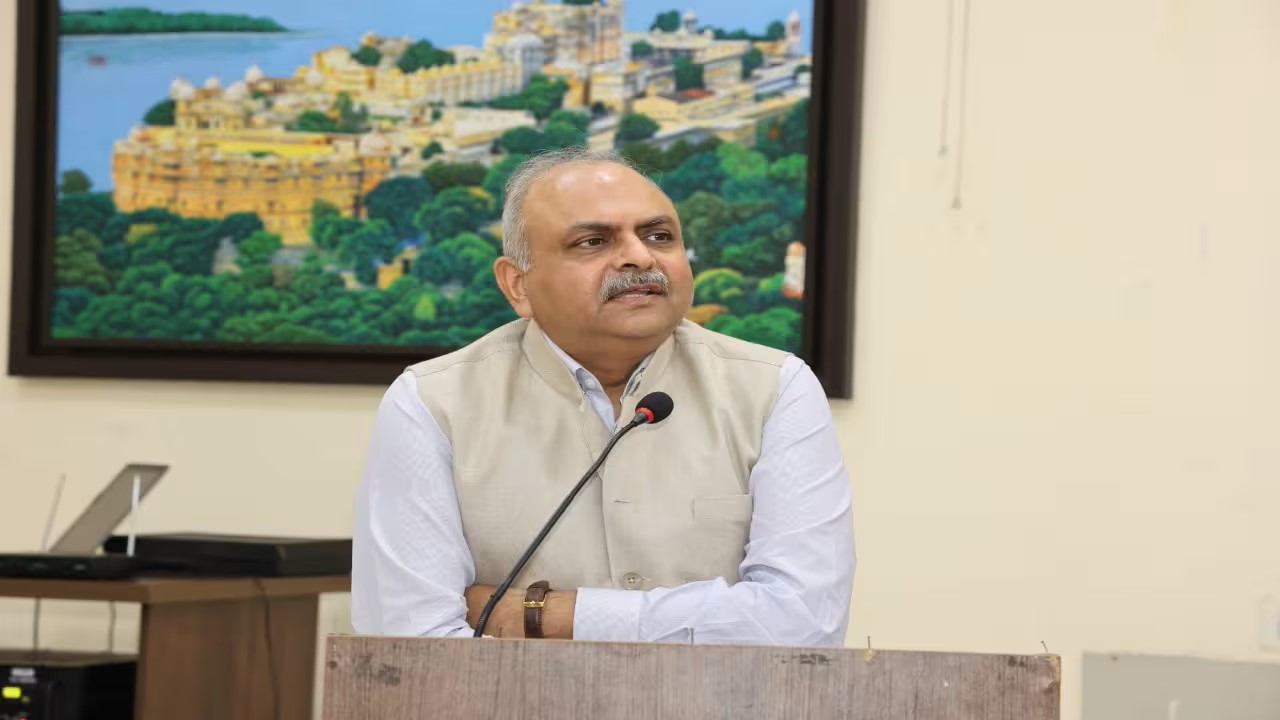Advertisement|Remove ads.
Exclusive | Confident of achieving ₹25 lakh crore tax target despite modest pace: IT Dept Chief
Income Tax Chairman Ravi Agarwal emphasises that the department is simultaneously managing revenue pressures and a major transition to the new Income Tax Act, 2025. He notes that fresh tax forms are being redesigned to reduce taxpayer burden, while refund delays are largely linked to a surge in suspicious claims now under scrutiny.

With tax collections lagging behind the annual target of ₹25 lakh crore and industry concerns building around delayed refunds, tighter TDS timelines and long-pending appeals, the Income Tax Department finds itself navigating a complex compliance landscape.
In an exclusive interview with CNBC TV18’s Timsy Jaipuria, Income Tax Chairman Ravi Agarwal addresses concerns around the collection trajectory, the new Income Tax Act, refund delays, fraudulent claims, TDS corrections and the status of litigation disposal.
While maintaining confidence in meeting the fiscal’s revenue goals, he outlines the administrative pushes underway as the department transitions to the new tax framework.
Below is the edited transcript of the interview.
Q. The tax collection target is ₹25 lakh crore, but the current pace is modest. How confident are you about meeting the remaining collection requirements this year?
A. The due date for filing tax returns has been extended till December 10. And we hope that by that time — when all the returns are filed because while filing the returns, self-assessment tax also is paid — we should be able to compare... But looking at the current trends, I am hopeful that we should be able to meet the targets.
We are up by about 6.99%. When we had estimated this budget target for this year, all the relaxations that had been given last year had been newly factored in.
What is also to be seen is that we have two instalments of advance tax which are upcoming, December 15 and March 15. Taken together, we should be able to meet the targets.
Q. The new Income Tax Bill is in place, but rules and forms are still awaited. How is the department progressing on that front, and what does it mean for return processing, especially since many refunds from this fiscal are still pending?
A. As far as the rules and forms are concerned, we are designing the forms and framing the rules. The endeavour is to simplify the forms because that's the first interface through which the tax payer interacts with the department. The forms have to be contextual and the information, the data that we capture through the forms should be very relevant (keeping in mind) the ease of doing business and the fact that we don't necessarily burden the tax payer with filling up irrelevant information.
So we are reviewing the existing forms and aligning with the current income tax Act, which is Income Tax Act 2025 which we will be rolling out. So that exercise is on.
Q. By when can taxpayers expect these new rules and forms to be issued?
A. By the end of this year or early next year.
Q. Industry has been raising concerns that refunds this year are delayed. What is causing the slowdown?
A. Regarding refunds, we had done some exercises. We have taken action where we found that certain refunds had been fraudulently claimed and those are being analysed before the refunds are released.
That is why it is taking some time in respect of the refunds which are generally red flagged or which are high value. But we are conscious about it and we are analysing.
Q. In which areas or sectors were these fraudulent refund claims seen?
A. It is across the sectors and specifically deductions which have been claimed.
Q. Tighter TDS timelines have left several industries saying they are unable to utilise unconsumed TDS and are struggling with corrections. Appeals, too, remain pending for long periods. How is the department dealing with these systemic pressures?
A. As far as the TDS and the shortened window are concerned, this provision came only last year and the taxpayers and deductors have sufficient time. Even now, they have about four months to correct the statement wherever they will find the gap... the window of correction of the TDS statements earlier was unlimited, (then) it was made six years and now it is two years.
Two years is again a big period and wherever correction is required, you have another four months down the line till March to correct it.
In fact, I would take this opportunity to appeal to the deductors that in case there is a gap, this is the time that they should correct it.
One should appreciate that it is basically an integrated system and we process the returns and we promise to process the returns of the taxpayers quickly. So it should not happen that the return is processed and subsequently a TDS is corrected. That adds to the public remands also.
So I would appeal to the deductors to immediately correct, wherever required.
Q. What about bringing down litigation levels, especially pending appeals?
A. In litigation, we have taken many steps and our appellate authorities are working overtime to ensure that the pendency is liquidated. There were prior years where because of COVID the pending cases accumulated.
But I must share that this year more than about 40% disposal has been done in appeals compared to last year. And I think we will end the year with a much higher number of appeals.
In an exclusive interview with CNBC TV18’s Timsy Jaipuria, Income Tax Chairman Ravi Agarwal addresses concerns around the collection trajectory, the new Income Tax Act, refund delays, fraudulent claims, TDS corrections and the status of litigation disposal.
While maintaining confidence in meeting the fiscal’s revenue goals, he outlines the administrative pushes underway as the department transitions to the new tax framework.
Below is the edited transcript of the interview.
Q. The tax collection target is ₹25 lakh crore, but the current pace is modest. How confident are you about meeting the remaining collection requirements this year?
A. The due date for filing tax returns has been extended till December 10. And we hope that by that time — when all the returns are filed because while filing the returns, self-assessment tax also is paid — we should be able to compare... But looking at the current trends, I am hopeful that we should be able to meet the targets.
We are up by about 6.99%. When we had estimated this budget target for this year, all the relaxations that had been given last year had been newly factored in.
What is also to be seen is that we have two instalments of advance tax which are upcoming, December 15 and March 15. Taken together, we should be able to meet the targets.
Q. The new Income Tax Bill is in place, but rules and forms are still awaited. How is the department progressing on that front, and what does it mean for return processing, especially since many refunds from this fiscal are still pending?
A. As far as the rules and forms are concerned, we are designing the forms and framing the rules. The endeavour is to simplify the forms because that's the first interface through which the tax payer interacts with the department. The forms have to be contextual and the information, the data that we capture through the forms should be very relevant (keeping in mind) the ease of doing business and the fact that we don't necessarily burden the tax payer with filling up irrelevant information.
So we are reviewing the existing forms and aligning with the current income tax Act, which is Income Tax Act 2025 which we will be rolling out. So that exercise is on.
Q. By when can taxpayers expect these new rules and forms to be issued?
A. By the end of this year or early next year.
Q. Industry has been raising concerns that refunds this year are delayed. What is causing the slowdown?
A. Regarding refunds, we had done some exercises. We have taken action where we found that certain refunds had been fraudulently claimed and those are being analysed before the refunds are released.
That is why it is taking some time in respect of the refunds which are generally red flagged or which are high value. But we are conscious about it and we are analysing.
Q. In which areas or sectors were these fraudulent refund claims seen?
A. It is across the sectors and specifically deductions which have been claimed.
Q. Tighter TDS timelines have left several industries saying they are unable to utilise unconsumed TDS and are struggling with corrections. Appeals, too, remain pending for long periods. How is the department dealing with these systemic pressures?
A. As far as the TDS and the shortened window are concerned, this provision came only last year and the taxpayers and deductors have sufficient time. Even now, they have about four months to correct the statement wherever they will find the gap... the window of correction of the TDS statements earlier was unlimited, (then) it was made six years and now it is two years.
Two years is again a big period and wherever correction is required, you have another four months down the line till March to correct it.
In fact, I would take this opportunity to appeal to the deductors that in case there is a gap, this is the time that they should correct it.
One should appreciate that it is basically an integrated system and we process the returns and we promise to process the returns of the taxpayers quickly. So it should not happen that the return is processed and subsequently a TDS is corrected. That adds to the public remands also.
So I would appeal to the deductors to immediately correct, wherever required.
Q. What about bringing down litigation levels, especially pending appeals?
A. In litigation, we have taken many steps and our appellate authorities are working overtime to ensure that the pendency is liquidated. There were prior years where because of COVID the pending cases accumulated.
But I must share that this year more than about 40% disposal has been done in appeals compared to last year. And I think we will end the year with a much higher number of appeals.
Read about our editorial guidelines and ethics policy












/filters:format(webp)https://news.stocktwits-cdn.com/large_Getty_Images_2245854960_jpg_32da4b39bd.webp)
/filters:format(webp)https://news.stocktwits-cdn.com/IMG_4530_jpeg_a09abb56e6.webp)
/filters:format(webp)https://news.stocktwits-cdn.com/large_micahel_saylor_OG_2_jpg_286b612773.webp)
/filters:format(webp)https://st-everywhere-cms-prod.s3.us-east-1.amazonaws.com/Prabhjote_DP_67623a9828.jpg)
/filters:format(webp)https://news.stocktwits-cdn.com/large_Musk_Space_X_f4993b185d.webp)
/filters:format(webp)https://st-everywhere-cms-prod.s3.us-east-1.amazonaws.com/Rounak_Author_Image_7607005b05.png)
/filters:format(webp)https://news.stocktwits-cdn.com/large_Michael_Burry_jpg_fa0de6ac92.webp)
/filters:format(webp)https://news.stocktwits-cdn.com/large_kevin_hassett_resized_jpg_84f224d945.webp)
/filters:format(webp)https://news.stocktwits-cdn.com/large_Getty_Images_2243898515_jpg_248ded048d.webp)